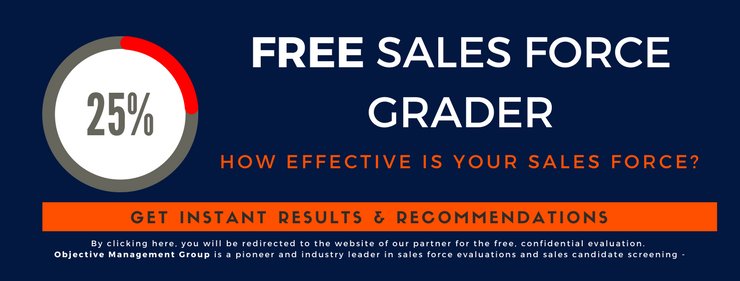
Selling has changed since 2008.
As Objective Management Group (OMG) states, the most significant changes are that:
- It’s more challenging to reach prospects
- Prospects don’t have time to meet
- There’s greater resistance
- Salespeople tend to be invited in later in the sales cycle
- There’s more price sensitivity
- Prospects are more cautious and conservative on what they spend their money
- There’s a greater need to differentiate
Consultative Selling is a sales approach that helps salespeople deal with those changes.
Interestingly, it might be the most misunderstood term in sales. Most believe that a salesperson must ask questions, identify an issue and present a solution. That definition isn’t wrong, but it falls short of the intended meaning, and most salespeople aren’t selling this way.
Instead, they have some prepared questions, ask some of them, and when a question leads to an issue, they begin to talk about a solution.
To get a full understanding of what consultative selling is, let’s look at the following items:
- The definition of consultative selling
- Consultative selling skills
- Consultative selling questions
- Consultative selling examples
- The best consultative sales approach
- How to do consultative selling
Consultative selling definition
Consultative selling is a sales approach that, when properly executed, can help a salesperson differentiate, sell value, and be viewed as a trusted advisor. Consultative selling requires salespeople to asked enough questions to go as wide and deep as possible, leading to a discussion of issues, opportunities, implications, the people they affect, and potential outcomes.
As much as consultative selling relies on highly developed questioning skills, equally well-developed listening skills are an even more critical component.
Consultative selling isn’t…
Consultative selling isn’t merely about asking questions. Many salespeople think they have a consultative approach the moment they ask questions for 15 minutes.
Nor is it about researching target companies before calling them or contacting someone at the bottom of the organizational chart to get information before reaching out to the top of the hierarchy (that’s Strategic Selling).
Consultative selling doesn’t consist of qualifying prospects before knowing if they fit and if your company suits them (that’s Solution Selling).
Consultative selling vs. transactional selling
Many companies only use a transactional selling approach. Depending on the nature of the product or service to be sold (some are better suited to one method or both at the same time), the usual consequence is that closing rates are too low, and sales cycles are too long; they need to discount prices and consequently, reduce profit margin.
Representatives have everything to gain by using consultative selling, and this, without eliminating transactional sales.
In most cases, the ideal is to first sell first consultatively, then to move on to a more transactional approach. Not only will the sale be natural, but the conversion rate will also improve.
Does consultative selling mean educating clients?
A lot of sales leaders and salespeople still believe that educating their clients will help build a bond with them.
Remember, one of the ways sales has changed is that salespeople tend to be invited in later in the sales cycle. One reason is that they’re now able to educate themselves online. They’ll often turn to sales reps when they need help filtering through all the content.
So educating clients keeps the conversation intellectual, yet most purchasing decisions are emotional. The consequence is that salespeople usually fall in the trap of consulting for free and switch too quickly to solution selling mode. They educate their clients by using their technical knowledge instead of using their expertise to ask good questions.
Consultative selling is, therefore, not about educating. It requires the salesperson to be proactive and ask a lot of good, great and difficult questions. The goal isn’t to teach, but rather to identify the compelling reasons to buy.
Indeed, it is the rep’s responsibility to identify the problems experienced by the client, then to discuss the client’s deep motivations or compelling reasons the problem creates.
Take a prospect who’s dissatisfied with a supplier. Educating them means telling them how you’re different. Consultative selling means discovering that they’re dissatisfied because they keep missing deadlines which, in turn, causes the prospect to have problems with their boss and staff and leads them to fear for their job.
Which avenue do you think increases the probability of a sale?
It’s essential to differentiate between the expressed problem and the compelling reason to buy.
Consultative selling skills
The consultative seller ability is one of the 21 key sales competencies. It’s a technical sales skill which means it’s relatively easier to learn and develop if a salesperson has a Sales DNA that supports the ability.
All consultative selling skills
- Stay in the moment
- Capable of uncovering the compelling reasons to buy
- Listen and ask with ease
- Ask enough questions
- Ask great questions
- Will to build trust
- Ask tough questions
- Take nothing for granted
- Manage an appropriate amount of patience
- Understand how prospects will buy
- Develop strong relationships
- Present at proper times
- A healthy amount of skepticism
Consultative selling questions
Consultative selling is about asking a lot of questions. Salespeople need to ask questions for at least 45 minutes if they want to discover all the information necessary for a truly consultative sales approach.
Most of our clients are stunned when they discover that they have to spend so much time asking questions. They’re also surprised to see how asking and answering only a few essential items (a dozen or so) can take 45 minutes.
The other thing about consultative selling questions is that they need to be challenging, insightful and thorough – they should shake the prospect’s beliefs and perceptions.
These are the questions that make the client talk about important things without the representative having to convince him/her. Questioning means the discussion is focused on the potential customer and his or her issues. With consultative selling, the best presentations are those that are never made!
It’s only by asking enough questions and hard questions that salespeople gain credibility, position themselves as advisors and sell value.
Asking questions doesn’t mean prospects should feel it as an interrogation. Salespeople need to be empathetic and use what potential customers tell them to build a bond.
Consultative selling examples
There are many consultative selling methodologies:
- Sandler Training
- Miller-Heiman, Strategic Selling
- Solution Selling (SPI)
- SPIN Selling
- ValueSelling
- Customer-Centric Selling
- RAIN Sales Training
- Target Account Selling
- The Challenger Sale
- Baseline Selling
The most famous is probably The Challenger Sale because Harvard Business Review featured it.
The best consultative sales approach
Prima Resource, however, uses and implements Baseline Selling, because it’s the easiest and most complete consultative sales approach.
The 4 steps of Baseline Selling
Baseline Selling uses the baseball field to represent the steps in the sales process.
- To 1st base: it’s at this stage that a rep targets ideal clients when prospecting. To get to the first base, the representative must contact a prospect and identify at least one problem to solve to get an appointment.
- To 2nd base: at this stage, reps must discover the compelling reasons to buy, quantify the prospect’s problem and differentiate themselves from the competition.
- To 3rd base: the decision criteria, the timeline and the competitors are now qualified.
- To home: The salesperson presents an offer based on what was discovered in the previous steps and close inoffensively.
A visual consultative sales approach
It uses the baseball diamond to illustrate the process. Whether you know baseball or not, everyone knows that you have to go around the bases and ultimately cross the home plate. Although consultative selling is often perceived as difficult to understand and apply, Baseline Selling addresses these difficulties with its visual approach.
When I present the methodology, it only takes a minute to understand the fundamental steps and a few more to remember the more detailed steps. The visual representation of the method ensures it’s retained fast without requiring an image or flow chart
A conversational approach
In sales, it can be challenging to remain authentic when using arguments and a sales pitch. The methodology’s secret is that it is fundamentally rooted in conversations. There’s no question of trying to convince potential customers, changing their minds or filling their heads with information.
Covering all steps of the sales process
Many sales methodologies, even if they’re consultative, don’t include all the elements of a sales process. Spin Selling, for example, is an excellent approach, but it doesn’t cover what’s necessary to prospect, qualify or conclude.
Baseline Selling starts before prospecting and continues to the close.
A customizable methodology
Fixed sales methodologies are ineffective and only partially executed because representatives tend to ignore what doesn’t seem to apply to them.
With Baseline Selling, the degree of customization is very high which allows companies to create variants based on the products sold and targeted markets.
How to do consultative selling
How to do consultative selling with purchasing departments
A consultative sales approach allows reps to talk to real decision-makers to sell them the “value” of products and services, not their price.
Often, however, salespeople find themselves having to go through the purchasing department to sell. As buyers receive orders from all the company’s business lines, their primary goal is to buy what is on their list at the lowest possible cost.
As a result, buyers aren’t inclined to buy the value of products or services; they generally stick to the final price and therefore to the lowest bidder.
How to apply a consultative sales process with buyers?
Avoid the purchasing department altogether.
Contrary to popular belief, in most cases, it’s not a must to go through the purchasing department. Because buyers always focus on price, a good salesperson should never start the sales process with the purchasing department.
Even if a buyer contacts the salesperson first, it’s necessary to identify a way to bypass him or her with one of the recommendations below.
How can I avoid the company’s purchasing department?
- Find the person who’s experiencing difficulties and initiated the request. By directly offering the solution to their problem, the representative will emphasize the value of his solution and the simple comparison on his price will no longer hold.
- Ask questions to which buyers don’t have the answers. The best way to bypass the purchasing department is to ask technical questions or ones related to the need or business problem. Buyers don’t usually have answers to those questions and, as a result, representatives may ask to speak with the decision-maker(s) for answers to their questions.
- If the purchasing department is impossible to bypass, the best thing to do is to limit contacts as much as possible, and make sure that the real decision-maker has made their decision before forwarding the file to purchasing for the administrative side.
Leverage your CRM to deploy and monitor your consultative sales process
Companies should use CRM to improve their sales performance through systematic process management. Although this is an excellent intention, our consultant Louis Larochelle, often finds that companies don’t exploit their CRM to its full potential.
Typically, when acquiring software such as Salesforce (SFDC) or Microsoft Dynamics, the basic version includes a few basic sales process steps. Too few and insufficiently detailed, they aren’t specific to each company. Each organization has its reality, and the sales process should reflect this.
When companies are satisfied with the basic version of the software, without trying to adapt it to their reality, their representatives don’t follow the process.
Map the Baseline Selling consultative sales approach to your CRM to gain a better overview of each step and opportunity in the sales process because it details each component of the steps, from prospecting to closing the sale.
By integrating your consultative sales approach like Baseline Selling directly in your CRM, you get accurate daily monitoring as well as coaching opportunities for sales managers.
How to map Baseline Selling to your CRM
- Microsoft Dynamics: this CRM allows you to integrate all the components of the different stages of Baseline Selling, either within the “Opportunity” window or by designing a process. This customization isn’t always easy, but the software allows it.
- Salesforce: with SFDC, it’s more complicated. It’ll usually be a certified consultant who must do the customization – which can be quite expensive.
- In both cases, there is another option. Membrain is a CRM designed for complex B2B sales that Membrain is the only CRM for B2B sales that puts “how to sell” at the heart of the software. Sales departments can use it as a standalone CRM or with their current CRM by integrating a component within SFDC or Dynamics. Membrain is easy to customize and implement the components of Baseline Selling or create a customized sales process without the need for an external consultant.
The integration of Membrain into SFDC or Dynamics is by far the most effective option.
Conclusion
Sales has changed.
Implementing a consultative sales methodology, like Baseline Selling, helps your salespeople evolve with their times. Better equipped, they can better support their prospects, increase their sales and improve your company’s health.
65% of salespeople are either strong or fair consultative sellers. It’s by far the competency where reps are the weakest.
There are four reasons why salespeople are bad at consultative selling:
- They need to be liked so they won’t ask a question if they think the prospect will get upset with them for asking.
- They don’t have the listening skills required to ask good questions.
- Most salespeople have never been trained or coached to sell consultatively.
- Most salespeople are best at presenting and aren’t patient enough to wait for the opportunity to do so presents itself.
Note: This post was originally published on December 21, 2018, and has been reviewed and revamped for accuracy and comprehensiveness.






